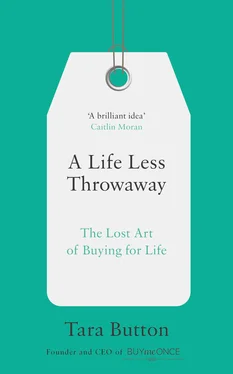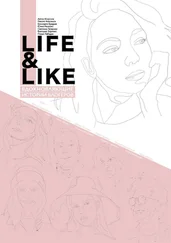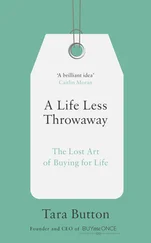In 1941 the first television ad was shown, during a baseball game between the Brooklyn Dodgers and the Philadelphia Phillies. It presented a map of America with a Bulova-branded watch face superimposed over the top. A deep male voiceover announced proudly, ‘America runs on Bulova time.’ And that was it. Ad over.
If only all advertising breaks were that short. Now in America, of the five hours that the average person watches TV, 2approximately 1.2 hours will be adverts. 3
This has led me to the terrifying realisation that the average person is watching over three and half years of adverts over a lifetime! If a pal called you up and said, ‘Hey! Let’s spend the next three and half years watching commercials,’ you might well question their sanity. But this is what many people are choosing to do. To me, three and a half years sounds like a prison sentence, but in this case the prison constantly asks for your money and gets irritating songs stuck in your head.
Digital ads are now the new town criers, and they don’t even play the lute. We now see and hear an estimated 362 ads a day and over 5,000 ‘brand exposures’ from logos and other branding devices. 4It’s no wonder that this has massively affected our behaviour. Even if we claim, as many of us do, to ‘never pay attention to ads,’ the sheer number of them, coupled with the activity of our ever-curious brains, means their messages sink in somehow, shifting our ideas of what’s important and how we feel about things.
Mindful curation therefore can’t just be about being mindful of the objects we allow into our lives, but also has to be about being mindful of the messages and content as well. This needn’t mean a media blackout, rather that we should aim to identify the sources that nurture us and give us the information we need to make good choices. To everything else we can say, ‘Thanks, but no thanks.’
Rather creepily, there are thousands of people now working on ways of getting more ads in front of our eyes every day. In the future, who knows, there may be a way to beam adverts directly into our brain. With home appliances becoming part of the ‘internet of things’, don’t be surprised if in a few years’ time, your fridge starts giving you suggestions as to what you might like to fill it with.
If we want to stay mindful, we should be on the lookout for anything that sneaks ads into our homes or heads via the back door. Our homes need to be a sanctuary if we are to stay sane in the next millennia. So, in the words of one of my favourite Harry Potter characters, ‘Constant vigilance!’
THE SEDUCTION OF SYMBOLISM
The biggest change that I’ve seen in advertising, and something that particularly affects us when we’re trying to practise mindful curation, is the switch from useful detailed information to help with making choices to symbolism and manipulation. You may have noticed that in many ads today, you might not even see the product, just an idea with the brand’s logo on it.
For example, when Levi’s invented their jeans in the 1870s, some of their earliest adverts showed two horses trying to rip a pair of jeans apart. The line went ‘They never rip’ and the advertisement then went into detail on the quality and construction of the jeans.
In comparison, a Levi’s advert in 1998 showed a hamster called Kevin running on a wheel to heavy metal music. A little boy speaks over the top:
‘Kevin loved his wheel, but one day … it broke.’
The music stops and the hamster wheel stops working. The light fades in the room as night falls.
‘Kevin grew bored …’
We see the sun rise and Kevin standing still in the cage. Then a pencil pokes him through the bars and he falls over into his sawdust.
‘… and died.’
The ‘Levi’s Original’ logo then appears and the ad ends. 5
At the time, this ad caused quite a few complaints, but what I find interesting is just how far away the ad is from the product it is advertising. A depressed hamster has nothing to do with jeans and yet Levi’s wouldn’t have paid hundreds of thousands of dollars to run this ad unless they thought it would increase sales, so what’s going on?
What this ad manages to do very well is create a powerful reaction of shocked laughter/disbelief at the same time as we see the Levi’s logo. This is classic subliminal messaging. When we next see the Levi’s logo, maybe in a shop or online, that feeling of heightened activity in our brain will return as an echo in our mind. We probably won’t remember the ad, but we will feel a slight thrill – a thrill that will make us far more likely to remember the brand, pay attention to the jeans and buy them.
The ad may also be saying that Levi’s are for people who love to move or who can’t bear to be still and bored. They’re for people who want to ‘live’. That is a sentiment that might resonate with many, and it might even make them feel a closeness to the Levi’s brand, but it has no basis in the reality of the product.
I believe that this shift from talking about the attributes and quality of a product to the symbolic qualities of a brand goes hand in hand with why the quality of products has fallen. At some point, companies realised they just needed to sell us an idea, and if we bought into the idea, we’d probably buy the product too. So they didn’t need to put their efforts into making the best products possible, just into making the best ads.
It is the same with customer service. It’s easy to see where brands’ priorities lie when companies spend $500 billion on marketing and advertising globally compared to just $9 billion on customer service. 6The average sales rep might make double the salary of the poor old customer service rep who is the one who has to deal with the irate and potentially sweary customers.
Many companies will charm you right up to the moment you’ve bought their product, and then you’ll be invisible to them until they can flog you something that’s ‘even better’. In the meantime, what is to be done with their product if it breaks is ‘not their problem’.
It is the companies who break this pattern that have the potential to become BuyMeOnce brands. These are the people who believe in their products and commit to their customers. They will make you feel like a valued customer before your purchase and for many years into the future. They may be hard to find, but I’m happy to report that they do exist.
BEYOND SELLING – HOW ADVERTISING IS AFFECTING HOW YOU THINK
What’s less obvious about advertising but important not to overlook is that it doesn’t just sell us things, it also sells us its own moral code. It has a significant amount of power to shape our beliefs by showing us what’s acceptable and what’s not. Currently, it mostly shows us a creepy, fun-house mirror version of our world, where almost everyone has over-white teeth, thigh gaps and immaculate houses, and people of colour are tolerated, so long as they aren’t ‘too black’.
That was a direct quote from one of my clients, by the way. A lot of progress towards equality has been made, but from my experience there’s still some way to go.
A couple of years ago I was writing a TV ad and was specifically asked to show lots of different types of people enjoying the product in different ways, so I wrote a gay couple into the script. They were going to be in dressing gowns in their kitchen stealing bits of each other’s breakfast, but the feedback from the client was that we could have two men in the scene ‘so long as they didn’t touch, flirt or look at each other too long’.
‘So they want flatmates,’ I said. ‘They can’t be gay because…?’
I never got an answer to that question, and my colleagues couldn’t understand why I was livid and throwing all my toys out of the pram.
Читать дальше












